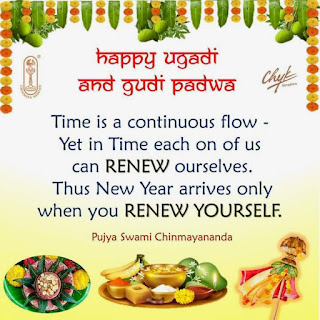Happy Hindu New Year.
1946 Shalivahana Saka Samvat. 2081 Vikram Samvat. 5126 Yugabda.
Each Hindu New Year has a new name. In this New Year named Krodhi, may we be peaceful, prosperous, positive and pure.
3 Hindu Calendars:
Deduct 78yrs from the present gregorian year to arrive at the Saka Year. It is the Indian Civil Calendar & used in Govt. Communications. The beginning of the Saka era is widely equated to the ascension of King Chashtana of Ujjain, to Mahakshatrapa in 78 CE.
Emperor Vikramaditya of Ujjain started Vikram Samvat(Historical Hindu Calendar) in 57 BCE & it is believed that this calendar follows his victory over the Saka in 56 BCE
Yugabda is based on Kaliyuga Sankhya preserved by Indian Astrology. Kali Yuga began 5,124 years ago.
Puranic Reference for Chaitra Pratipada:
Brahmapurana mentions that Brahma created the world on the first day of the bright half of Chaitra at sunrise & started the reckoning of time. On that tithi a Mahashanti destroying all untoward occurrences & sins should be offered. First Brahma should be worshipped & then the other gods with mantras preceded by Om & the word namah (Om Namo Brahmane Tubhyam). Worship all divisions of time from the minutest to Yugas, daughters of Daksha & Vishnu. Honour the priests with food & fees. Give presents to relatives & servants. Homa should be offered to Agni called Yavishtha, special food should be prepared & a great festival should be celebrated.
Bhavishyapurana says that since it was declared by Brahma to be the best among tithis & thus placed in the first place it is called Pratipada.
How should one celebrate?
1. Worship the Lord of the Year, viz. the Lord of the week-day on which the Pratipada falls.
2. Arches & banners should be raised by each householder.
3. Anoint one’s body with oil & have a bath.
4. Eat leaves of the nimba tree or neem
5. Hear from the reciter of the calendar the name of the year, its Lord & the deities that would be the ministers for the year, the governing deities of all corns & fluids etc. Even today priests go about in the Deccan to the houses of their patrons & read from the Panchanga(almanac) these details.
6. Raise a pole with silk cloth at the top, covered with a silver or brass pot, offer worship to the pole with sandalwood paste, flowers etc.
(Source Courtesy: Dr.P.V.Kane’s History of Dharmashashtras)
People proudly hoist their flag or cross over their homes/colonies. There should be an orange flag with Om or Jai Sri Ram or any other slogan/deity on it constantly on the top of Hindu homes.
The most widely accepted New Year’s Day among the Hindus is the Caandramaana Yugaadi, the first day of the bright half of the month of Chaitra(March-April).
Brahma, the Creator is said to have created this world on this day and the reckoning of time begun from the sunrise of this day. Hence the name Yuga-Adi (Beginning of an era or epoch).
Brahma, the Creator is said to have created this world on this day and the reckoning of time begun from the sunrise of this day. Hence the name Yuga-Adi (Beginning of an era or epoch).
Emperor Shalivaahana(79 CE) is believed to have been crowned on this day. Consequently this era is called the Shaka Era or the Shalivaahana Shaka.
What to do on the Hindu New Year?
Sadhanas:
1. Paschaataapa or repentence for the evil deeds committed during the past year
2. Prayers for forgiveness
3. Performance of Mahaashaanti rites to ward off all future evils or misfortune
4. Worship of the presiding deity of the year as indicated by the day of the week on which the Yugaadi falls
5. Worship of Brahmaa the creator with all the Upacharas
6. Worship to other deities, to units of time and nakshatras or asterisms and
7. Worship of Vishnu - are the religious rites specially recommended.
8. One must also listen to the reading of the Panchanga by the family priest. Listening to the forecasts given in the Panchanga can help one to prepare oneself for facing all the upcoming challenges of life.
Celebrations
9. Take bath after anointing the body with oil, called Abhyanjanasnaana or oil bath
10. Wear new clothes
11. Decorate the house
12. Eat a mixture of tender neem leaves and jaggery followed by a sumptuous feast
13. Give presents to servants and dependents - these are the social aspects of the celebration.
Eating the mixture of the bitter neem leaves along with the sweet jaggery is supposed to be good for health and also an antidote for the illnesses common in the spring season. Taken in a symbolic sense, it can psychologically prepare one to be equanimous under all circumstances of life, whether bringing pain or pleasure.
Chaandramaana Yugaadi is observed widely as the New Year’s Day in Andhra Pradesh, Karnataka and Maharashtra. In some parts of the country, especially in Maharashtra, a long bamboo is decorated with a silk cloth and a silver or copper vessel is put over it. A garland of sweets and neem leaves, it is tied at the upper end. This is called ‘Gudhi.’ This is then worshipped and hoisted on the terrace of the house. It is taken down after sunset and the sweets and neem leaves are distributed among all, especially the children, to be consumed as prasada or consecrated food. Because of this custom of raising the Gudhi on the Padhva(or Pratipad day), the day(yugadi) itself is called as “Gudhi Padva”
According to one belief, this is actually a flag-hoisting ceremony to commemorate the killing of Vali, the monkey chief of Kishkindha, by Sri Rama on this day.
According to one belief, this is actually a flag-hoisting ceremony to commemorate the killing of Vali, the monkey chief of Kishkindha, by Sri Rama on this day.
- Courtesy “Encyclopaedia of Hinduism by Swami Harshananda, Ramakrishna Math”
Shubh Yugadi / Ugadi / Padva





